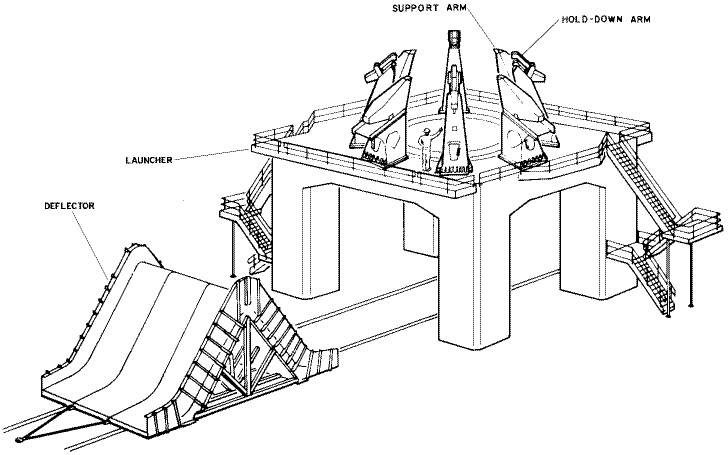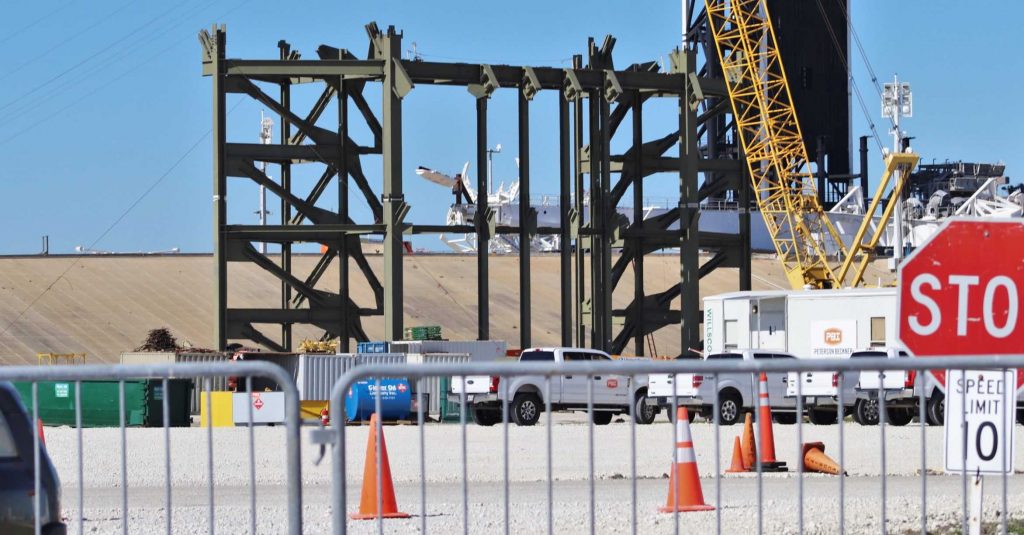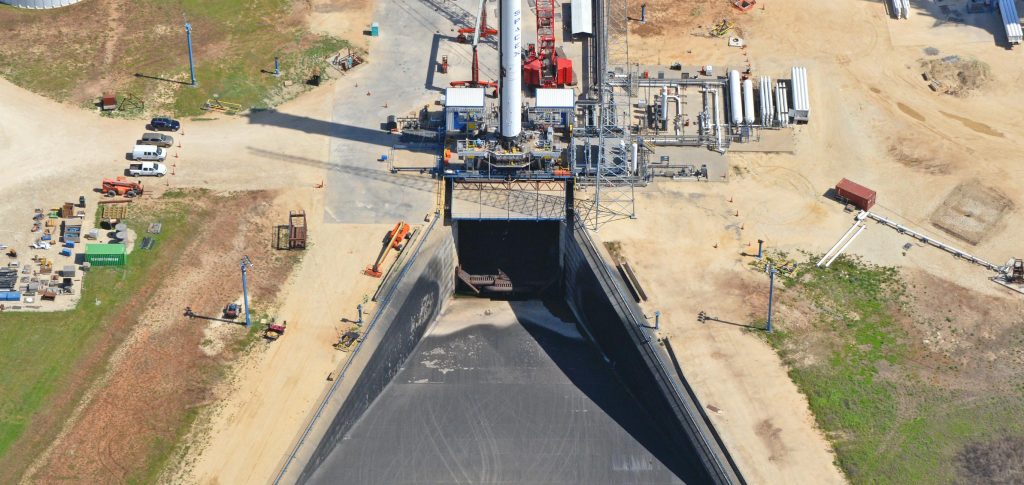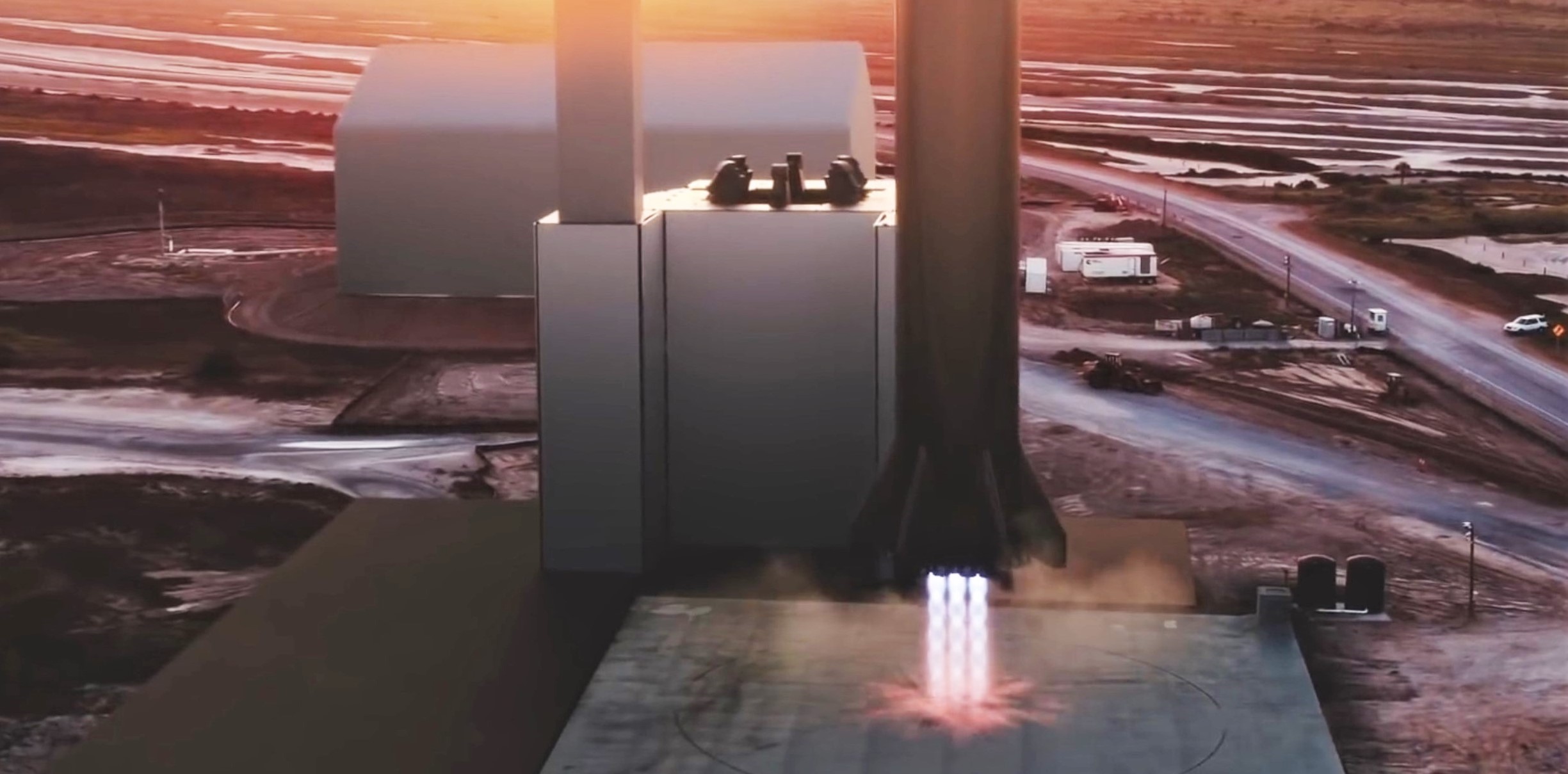Over the last few weeks, SpaceX’s Florida Starship launch pad construction has made some major progress and the structure that will one day support the first East Coast Starship and Super Heavy flight tests have grown several stories tall and show no signs of slowing down.
In a bid to make what could otherwise be an extremely expensive and time-consuming ordeal much faster and cheaper, SpaceX’s Starship/Super Heavy launch pads will be quite a bit different from the company’s several existing launch pads. This includes Kennedy Space Center’s LC-39A pad, leased and operated by SpaceX for Falcon Heavy and Crew Dragon missions and formerly used for dozens of Space Shuttle launches and all Saturn V Apollo Moon missions.
In a very on-brand move, SpaceX has decided to build Starship’s East Coast orbital pad within the bounds of Pad 39A but without using the pad’s existing launch mount or concrete flame trench. Instead, SpaceX is building a separate steel mount and water-cooled thruster diverter designed to stand up to the fury of a Super Heavy booster without allowing the rocket’s plume to dig a crater in the ground after ever ignition.
While choosing to pursue a dramatically different launch pad design for Starship may at first glance seem risky, SpaceX actually has more than a decade of experience building and operating similar mount and flame diverter setups at its McGregor, Texas rocket development and test facilities. A step further, NASA itself once heavily relied on similar technologies and strategies to rapidly build, test, and fly rockets larger than anything that came before them.
Most notably, the Saturn I rocket that preceded the massive Saturn V used a launch mount and flame diverter that looks quite similar to a conceptual setup SpaceX recently showed off in an updated Starship launch render.


SpaceX’s Starship mount is substantially taller, has gone with steel instead of reinforced concrete, and will have a fixed flame deflector, but the similarities are otherwise significant. Conceptually, both mounts are topped with a flat surface with numerous support arms and a large cutout for the rocket to sit atop and its exhaust to exit through. Similar to Falcon 9, the single-core Super Heavy booster mount shown in SpaceX renders will likely have four hold-down clamps and two tail service masts (TSMs), umbilical connections that supply the rocket with propellant, electricity, connectivity, and any other required fluids.
As described and pictured above, Starship’s Pad 39A launch mount has rapidly grown from a few metal beams into a major structure in just the last few weeks. By rough estimate, the existing mount is already 20 or so meters (70+ ft) tall and has large mounts for the installation of additional structures on top of it, while the conceptual mount shown in SpaceX renders appears to be about 25-30 m (80-100 ft) tall.
In the last few days, technicians have begun installing the first framework of the flame diverter SpaceX will use to prevent Starship from damaging itself or its surroundings during static fires and launches. Given the fact that Starship’s Super Heavy booster – as currently described – will be the single most powerful launch vehicle in history, such a vast amount of energy is not easy to dissipate. To accomplish that task, SpaceX revealed in August 2019 planning documents that the 39A diverter would be water-cooled.

The largest thrust diverter SpaceX has built supports the company’s McGregor, Texas booster test stand and has supported dozens upon dozens of integrated static fire tests. Originally designed to enable integrated triple-booster Falcon Heavy testing, SpaceX ultimately decided not to use that capability but the diverter is still immense, likely measuring at least 15m (50 ft) tall and 10m (33 ft) wide. By building dozens of pipes into the surface and structure of the diverter and filling those pipes with recirculating water, it can survive several minutes of hot rocket exhaust without suffering catastrophic erosion or outright melting.
It’s safe to say that Super Heavy will require a diverter that is far larger still to survive thrust equivalent to more than three Falcon Heavy rockets, but that very diverter and launch mount are already well on their way to completion at SpaceX’s Kennedy Space Center launch pad.
Check out Teslarati’s Marketplace! We offer Tesla accessories, including for the Tesla Cybertruck and Tesla Model 3.
News
Tesla begins Robotaxi certification push in Arizona: report
Tesla seems serious about expanding its Robotaxi service to several states in the coming months.

Tesla has initiated discussions with Arizona transportation regulators to certify its driverless Robotaxi service in the state, as per a recent report from Bloomberg News. The move follows Tesla’s launch of its Robotaxi pilot program in Austin, Texas, as well as CEO Elon Musk’s recent comments about the service’s expansion in the Bay Area.
The Arizona Department of Transportation confirmed to Bloomberg that Tesla has reached out to begin the certification process for autonomous ride-sharing operations in the state. While details remain limited, the outreach suggests that Tesla is serious about expanding its driverless Robotaxi service to several territories in the coming months.
The Arizona development comes as Tesla prepares to expand its service area in Austin this weekend, as per CEO Elon Musk in a post on X. Musk also stated that Tesla is targeting the San Francisco Bay Area as its next major market, with a potential launch “in a month or two,” pending regulatory approvals.
Tesla first launched its autonomous ride-hailing program on June 22 in Austin with a small fleet of Model Y vehicles, accompanied by a Tesla employee in the passenger seat to monitor safety. While still classified as a test, Musk has said the program will expand to about 1,000 vehicles in the coming months. Tesla will later upgrade its Robotaxi fleet with the Cyercab, a two-seater that is designed without a steering wheel.
Sightings of Cybercab castings around the Giga Texas complex suggests that Tesla may be ramping the initial trial production of the self-driving two-seater. Tesla, for its part, has noted in the past that volume production of the Cybercab is expected to start sometime next year.
In California, Tesla has already applied for a transportation charter-party carrier permit from the state’s Public Utilities Commission. The company is reportedly taking a phased approach to operating in California, with the Robotaxi service starting with pre-arranged rides for employees in vehicles with safety drivers.
News
Tesla sets November 6 date for 2025 Annual Shareholder Meeting
The automaker announced the date on Thursday in a Form 8-K.

Tesla has scheduled its 2025 annual shareholder meeting for November 6, addressing investor concerns that the company was nearing a legal deadline to hold the event.
The automaker announced the date on Thursday in a Form 8-K submitted to the United States Securities and Exchange Commission (SEC). The company also listed a new proposal submission deadline of July 31 for items to be included in the proxy statement.
Tesla’s announcement followed calls from a group of 27 shareholders, including the leaders of large public pension funds, which urged Tesla’s board to formally set the meeting date, as noted in a report from The Wall Street Journal.
The group noted that under Texas law, where Tesla is now incorporated, companies must hold annual meetings within 13 months of the last one if requested by shareholders. Tesla’s previous annual shareholder meeting was held on June 13, 2024, which placed the July 13 deadline in focus.
Tesla originally stated in its 2024 annual report that it would file its proxy statement by the end of April. However, an amended filing on April 30 indicated that the Board of Directors had not yet finalized a meeting date, at least at the time.
The April filing also confirmed that Tesla’s board had formed a special committee to evaluate certain matters related to CEO Elon Musk’s compensation plan. Musk’s CEO performance award remains at the center of a lengthy legal dispute in Delaware, Tesla’s former state of incorporation.
Due to the aftermath of Musk’s legal dispute about his compensation plan in Delaware, he has not been paid for his work at Tesla for several years. Musk, for his part, has noted that he is more concerned about his voting stake in Tesla than his actual salary.
At last year’s annual meeting, TSLA shareholders voted to reapprove Elon Musk’s compensation plan and ratified Tesla’s decision to relocate its legal domicile from Delaware to Texas.
Elon Musk
Grok coming to Tesla vehicles next week “at the latest:” Elon Musk
Grok’s rollout to Tesla vehicles is expected to begin next week at the latest.

Elon Musk announced on Thursday that Grok, the large language model developed by his startup xAI, will soon be available in Tesla vehicles. Grok’s rollout to Tesla vehicles is expected to begin next week at the latest, further deepening the ties between the two Elon Musk-led companies.
Tesla–xAI synergy
Musk confirmed the news on X shortly after livestreaming the release of Grok 4, xAI’s latest large language model. “Grok is coming to Tesla vehicles very soon. Next week at the latest,” Musk wrote in a post on social media platform X.
During the livestream, Musk and several members of the xAI team highlighted several upgrades to Grok 4’s voice capabilities and performance metrics, positioning the LLM as competitive with top-tier models from OpenAI and Google.
The in-vehicle integration of Grok marks a new chapter in Tesla’s AI development. While Tesla has long relied on in-house systems for autonomous driving and energy optimization, Grok’s integration would introduce conversational AI directly into its vehicles’ user experience. This integration could potentially improve customer interaction inside Tesla vehicles.
xAI and Tesla’s collaborative footprint
Grok’s upcoming rollout to Tesla vehicles adds to a growing business relationship between Tesla and xAI. Earlier this year, Tesla disclosed that it generated $198.3 million in revenue from commercial, consulting, and support agreements with xAI, as noted in a report from Bloomberg News. A large portion of that amount, however, came from the sale of Megapack energy storage systems to the artificial intelligence startup.
In July 2023, Musk polled X users about whether Tesla should invest $5 billion in xAI. While no formal investment has been made so far, 68% of poll participants voted yes, and Musk has since stated that the idea would be discussed with Tesla’s board.
-

 Elon Musk1 week ago
Elon Musk1 week agoTesla investors will be shocked by Jim Cramer’s latest assessment
-

 Elon Musk3 days ago
Elon Musk3 days agoElon Musk confirms Grok 4 launch on July 9 with livestream event
-

 Elon Musk16 hours ago
Elon Musk16 hours agoxAI launches Grok 4 with new $300/month SuperGrok Heavy subscription
-

 News7 days ago
News7 days agoTesla Model 3 ranks as the safest new car in Europe for 2025, per Euro NCAP tests
-

 Elon Musk2 weeks ago
Elon Musk2 weeks agoA Tesla just delivered itself to a customer autonomously, Elon Musk confirms
-

 Elon Musk1 week ago
Elon Musk1 week agoxAI’s Memphis data center receives air permit despite community criticism
-

 Elon Musk2 weeks ago
Elon Musk2 weeks agoTesla’s Omead Afshar, known as Elon Musk’s right-hand man, leaves company: reports
-

 News2 weeks ago
News2 weeks agoXiaomi CEO congratulates Tesla on first FSD delivery: “We have to continue learning!”


















